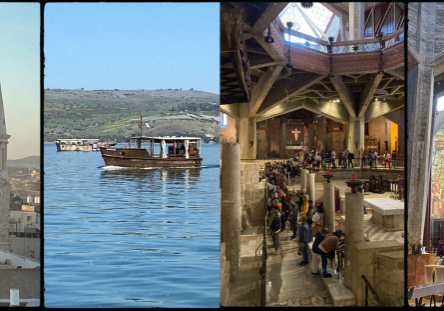So Great A Cloud of Witnesses!: The Story of the Hymn “For All the Saints” (ELW #422)
“Therefore, since we are surrounded by such a great cloud of witnesses, let us throw off everything that hinders and the sin that so easily entangles. And let us run with perseverance the race marked out for us, fixing our eyes on Jesus, the pioneer and perfecter of faith. For the joy set before him he endured the cross, scorning its shame, and sat down at the right hand of the throne of God.” Hebrews 12:1 and 2
By Rob Durocher
Minister of Music and the Arts, Deacon
One of the most beloved hymns of our faith that embraces the Festival of ALL SAINTS DAY, is the hymn “For All the Saints”, which has been sung for over 150 years in Christian churches throughout the world and is often sung for Services of Resurrection and Memorial Services.
All Saints Day, is on Nov. 1 this year. Many people are not as familiar with ‘All Saints Day’ as much as the day before which is known as All Hallows’ Eve (Halloween), but it is still a holy day for many Christian congregations and far more important in the life of the church. It is also an opportunity for us to give thanks for all those who have gone before us in faith, those famous or obscure, including our loved ones who have passed and who are now part of the “communion of saints’ who have gone to glory.
One of the great mysteries of our faith is that every time we gather around the Lord’s Table we join the saints above and the saints below in mystic sweet communion.
And so, with your people on earth and all the company of heaven we will praise your name and join their unending hymn: Holy, holy, holy Lord, God of power and might, heaven and earth are full of your glory.
The hymn ‘For All the Saints’ (original title, For All THY Saints), was written in 1864 by the Rev. Doctor William Walsham How (1823-1897). How was the Anglican Bishop of Wakefield of the Diocese of Wakefield, England. His hymn was written as a commentary on the article in the Apostles’ Creed, “I believe in the Communion of Saints.”
Bishop How served various congregations and became a Suffragan Bishop (an assisting bishop who does not automatically succeed a diocesan bishop) in east London in 1879. In 1888, he became the Bishop of Wakefield where he was called the ‘poor man’s bishop’ and “the children’s bishop”. He had a passion for working with the marginalized and the destitute who lived in the slums of London and the factory workers in west Yorkshire. His desire to reach his flock led him to write several theological works refuting the current controversy of the day, the Oxford Movement which sought a more ‘Roman Catholic’ approach to ritual and belief within the Church of England. He also attempted to reconcile biblical creation with the theory of evolution. He would write over thirty hymn texts including for many hymns, including several for children in a collection called Poems and Hymns published in 1886.
In his hymn For All the Saints, William How portrays the relationship between ‘the Church Militant (the faithful on earth), and the Church Triumphant (the saints in heaven) which is greatly emphasized throughout this hymn. In the very first verse of For All the Saints, Bishop How points our eyes heavenward to the Church Triumphant which states the purpose of the hymn, that we sing praises to God for all the saints who have finished their course here on earth and have entered eternal life. “Whoever acknowledges me before men, I will also acknowledge him before my Father in heaven” (Matthew 10:32).
For all the saints, who from their labors rest,
Who Thee by faith before the world confessed,
Thy Name, O Jesus, be forever blessed. Alleluia!
The second verse reminds us that salvation and the living of a holy and courageous life is only possible by the grace of God. Only if God be our rock, our defender and our strength can we stand a chance in the battle of this earthly life. “For I do not want you to be ignorant of the fact, brothers and sisters, that our ancestors were all under the cloud and that they all passed through the sea. 2 They were all baptized into Moses in the cloud and in the sea. 3 They all ate the same spiritual food 4 and drank the same spiritual drink; for they drank from the spiritual rock that accompanied them, and that rock was Christ”. (1 Corinthians 10:1-4)
Thou wast their Rock, their Fortress and their Might;
Thou, Lord, their Captain in the well fought fight;
Thou, in the darkness drear, their one true Light. Alleluia!
The third verse of the hymn becomes the connecting verse where we who are here on earth – the Church Militant, share blessed communion with the heavenly saints because of our unity in Christ, and though we might feebly struggle while we’re here on earth, the vision of God’s glorious kingdom that they already share in – and our communion with them greatly encourages us as we are still builders of God’s kingdom on earth. (Hebrews 12: 1-2)
O blest communion, fellowship divine!
We feebly struggle, they in glory shine;
Yet all are one in Thee, for all are Thine. Alleluia!
While Bishop How wrote at least eleven verses for this hymn many hymnals today only include seven or eight of them, far too many to write about in this article. In every version however, the final verse brings us full circle from heaven to earth and back to heaven again where we get a glimpse of the magnificent procession that will continue for those who will come after us after we’ve made our own journey! This final verse is a reflection on John 12:32 where Jesus says: “And I, when I am lifted up from the earth, will draw all people to myself.”
From earth’s wide bounds, from ocean’s farthest coast,
Through gates of pearl streams in the countless host,
And singing to Father, Son and Holy Ghost:
Alleluia!
In this hymn William How gives us a powerful vision and awesome celebration of life in Christ. It also reminds us today that in this life though struggles, pandemic and when we falter we receive hope and encouragement from remembering the lives of these saints. In God’s grace and promise and In their example, we will be included in the “countless host, singing to Father, Son and Holy Ghost!” ALLELUIA!
The original tune for this hymn was called SARUM, composed by Joseph Barnaby (1838-1896) organist and choir master of St. Andrew’s, Wells Street, London. The tune that we use today is called SINE NOMINE (Latin for ‘without name’), composed in 1906 by the renown Ralph Vaughan Williams (1872 -1958). Vaughan Williams was a prolific English composer and editor of sacred, folk, and symphonic music. Perhaps one of his best loved anthems is his setting of The Old Hundredth Psalm Tune (Psalm 100), All People That on Earth Do Dwell, which premiered at the coronation of Queen Elizabeth II in 1953 and has been sung by thousands of choirs the world over ever since.
Related Posts

Holy Land Pilgrimage



